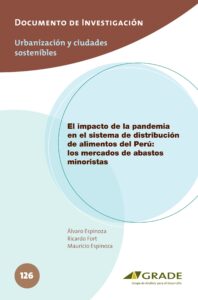El impacto de la pandemia en el sistema de distribución de alimentos del Perú: los mercados de abastos minoristas
| Year | : | 2022 |
|---|---|---|
| Author/s | : | Álvaro Espinoza, Ricardo Fort, Mauricio Espinoza |
| Area/s | : | Urbanization and sustainable cities |
Espinoza, A., Fort, R. y Espinoza. M. (2022). El impacto de la pandemia en el sistema de distribución de alimentos del Perú: los mercados de abastos minoristas (Documentos de Investigación N° 126). Lima: GRADE.
During 2020, the COVID-19 health emergency tested the effectiveness and resilience of Peru’s food distribution system, particularly in its most important part: traditional food markets, where more than half of household food expenditure is concentrated. The shock manifested itself in two dimensions: the reduction in demand for food from a suddenly impoverished population, and the prevention and control measures adopted by the national government.
Although the evidence is not abundant, it is possible to affirm that this situation generated a significant economic impact on food markets, more than on almost all other food distribution channels. However, in the medium term, these establishments were able to weather the storm, survive the extreme situation and eventually recover their pre-pandemic activity levels and their relative importance in the system. This resilience suggests that the institutional weaknesses of markets, associated with the informality of their governance, not only hide resources and capacities that can be mobilised in emergency situations, but also provide them with the necessary flexibility to adapt to times of crisis.







